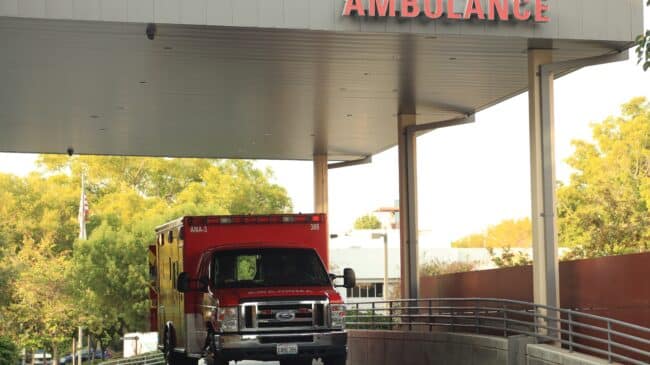Taxpayers throughout California should be concerned that firefighter unions are trying to convince local governments across the state to reshape and expand municipal fire departments’ control over emergency medical services. This move would have major implications for accountability, public safety costs, and government finances overall.
On a CalChiefs podcast, which its creators describe as “the voice of the California Fire Service,” Southern Marin Fire Protection District Deputy Chief Ted Peterson provided some details on exactly how municipal fire departments are seeking to take over emergency medical services (EMS) delivery from county-level EMS systems: increased reimbursements for transporting Medi-Cal patients through the Public Provider Ground Emergency Medical Transport (PPGEMT) program.
The federally-funded program is increasing nearly threefold, but the private ambulance companies that perform most of the EMS work for counties in California cannot access it. Thus, union officials argue that since municipal fire departments are already handling the first responder element of EMS and can access PPGEMT funds as a public agency, why not let these municipal fire departments control it all, draw more federal money, and strongarm ambulance contractors already providing services today into accepting less money for the same work by taking over their contracts from counties?
One reason the fire unions’ desired scenario would be problematic lies in their chosen accounting methods, which ensure fire unions would receive much more money for doing no more actual work. The federal reimbursement of the PPGEMT program doesn’t rely on any formal financial reporting documents, but a standardized, averaged reimbursement rate fueled by informal cost reports that are “proprietary to each agency so they cannot be shared,” as Peterson notes. Basically, each fire department must, on its own, determine how much it costs to perform its first responder function,s and those costs are averaged out to a flat reimbursement rate.
Setting aside obvious questions like how government cost reporting could possibly ever be considered “proprietary” and not transparently reported like other government budget figures, the podcast mostly served as a rallying cry for fire departments to adopt similar accounting practices and gimmickry to ensure those “informal” and “proprietary” cost reports show losses as high they can get away with, even encouraging colleagues to “appeal” if they get audited over their cost reports.
Over time, Peterson says, the increases will lead to “billions” of dollars for fire departments “for not doing anything except filling out some forms” and “increase(ing) our cost per transport two to three times what it is today.”
While shielding private intellectual property and trade secrets from public view is not unusual in private businesses in market competition, the same is not true of governmental budgetary information and financial statements, which require public, transparent reporting. Public agencies should not get special treatment to hide their accounting methods from taxpayers.
But there’s no reason to stop at accountability of accounting methods. For EMS to maintain effectiveness, much less improve, competition needs to be preserved. That becomes increasingly difficult as municipal fire agencies exploit their ability to access taxpayer funding to dominate EMS, while private ambulance company workers provide most EMS services. Peterson speaks of fire agencies playing a part of the larger EMS “team,” but typically, on a team, those who contribute the most get paid the most.
Instead, private ambulance companies could find themselves at the mercy of whatever municipal fire department administrators are willing to give them, threatening the exit of providers. The fire takeover of EMS in the city of Chula Vista has already shown that. The city raised the money provided for EMS to nearly $4,000 per trip, but the subcontractor company running the ambulances received less funding than they did under the previous arrangement and, overall, less than the fire agency that managed, but didn’t provide, the actual ambulance services.
What’s more, the Chula Vista fire department blamed the ambulance company for the rate increase it fought for, even though the incremental new revenue from the rate increase went to the fire department.
Those tactics threaten the exit of ambulance providers from the system entirely, which would be bad for taxpayers since fire departments are so dependent on them. Even if fire departments invest enough in ambulances, equipment, and services to provide full EMS, without competition and transparency, who is to say whether taxpayers are getting the best allocation of their funds?
Ironically, the podcast inadvertently highlights the need to emphasize cost and accountability. For example, if it costs over $2,000 for a trip to bring first responders to an accident, as Peterson claims in the podcast, the first thing to ask should be if there’s a way to do that more efficiently. How many emergency calls actually require the use of a ladder truck and personnel? Peterson says that departments charging much less were found to understate costs—should they not be subject to competitive pressure? Are there no better ways?
A level playing field between public and private actors best ensures EMS services in California toe the line between competitiveness and providing care to all patients. But California’s existing laws prohibit private EMS service providers from dedicated PPGEMT funding, so as fire agencies take over EMS, they can hold that funding over private providers’ heads based solely on their status as public agencies, as Chula Vista’s experience shows.
More so, EMS providers asking for federal reimbursement should open their cost accounting to the public. Fire departments insisting the cost accounting of their EMS first responder functions that go to determining federal awards remain hidden from public scrutiny should raise a red flag for every taxpayer. If fire departments are so confident their claims are legitimate, they should welcome the added transparency.

